GERMANY
Economy

Economy

Cities in GERMANY
| Berlin | Cologne | Dortmund |
| Frankfurt | Hamburg | Heidelberg |
Popular destinations GERMANY
| Bavaria |
Economy
General
After the Second World War, Germany developed rapidly into one of the most important industrial countries in the world. The gross national product (GNP) per capita is one of the highest in the world, comparable with that of the United States and Japan, and the German Mark (now: euro) is one of the most stable currencies in the world.
Germany has a social market economy in which the state is broadly in charge, but has no direct involvement in matters such as wage and price setting. The Kartellgesetz of 1957 protects competition against mutual agreements between companies. Labor peace has been largely preserved through comprehensive social legislation. The leadership by the state is expressed in, among other things, the Konzertierte Aktion, a tripartite consultation between the government, employers and employees' organizations to pursue economic policy. In the second half of the 1990s, Germany was faced with high unemployment, stagnation in growth and high budget deficits, partly as a result of the rapid unification process and the enormous costs involved.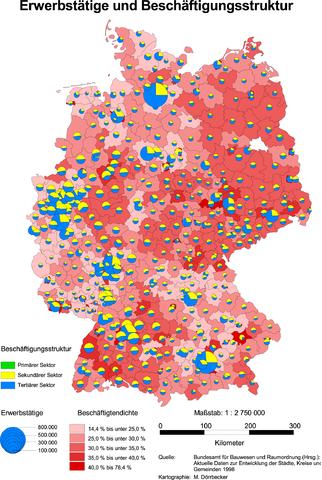 Employment and employment structure GermanyPhoto: Maximilian Dörrbecker CC 3.0 Unported no changes made
Employment and employment structure GermanyPhoto: Maximilian Dörrbecker CC 3.0 Unported no changes made
GDP rose from 163.5 billion euros in 1960 to 4171 billion euros in 2017. Despite the price increases, production continued to increase. Nearly half of GDP came from industry and mining, while the share of the agricultural sector has declined sharply in recent decades. The services sector, on the other hand, quintupled.
The GDP per capita amounts to $ 50,400 per year in 2017. The millions of refugees from the German Democratic Republic (GDR) contributed significantly to the “economic miracle”. However, economic reforms are slow. Germany is struggling with, among other things, an expensive welfare state, high wage costs and large expenditures on the backward East. Despite the credit crisis, the economy is growing by 3.4% in 2011 by 0.9% in 2012 and by 0.5% in 2013 and has now returned to the level of 2.5% in 2017. Unemployment is relatively low, at 3.8% in 2017, well below the European average. The figure in the east is still twice as high as in the west.
Share of sectors in gross domestic product (GDP) in 2017:
Agriculture and fishing 0.6%
Industry 30.1%
Services 69.3%
Agriculture, livestock, forestry and fishing
Although the agricultural sector contributes less than 1% of the German national product, productive, highly mechanized agriculture covers more than three-quarters of the domestic demand for agricultural products. The total number of farms is decreasing in Germany while the average farm size is increasing across the country. At present there are still more than 400,000 farms, of which approximately 95% are sole proprietorships. The smallest farms (33.2 ha) can be found in southern Germany, especially in Bavaria. The largest companies are located in the East German state of Mecklenburg-Vorpommern with an average size of 220 ha. The main agricultural state is Lower Saxony.
The main products of arable farming are cereals (especially in the lowlands in the north, Münsterland, Upper Palatinate and Bavaria), potatoes, sugar beets (in the Hanover-Brunswijk-Kassel triangle), and fruit, vegetables and wine.
Three quarters of the farms are organized in cooperatives and specialized chicken, pig and beef fattening farms are run very rationally. Despite redevelopment, small businesses still dominate and large businesses are mainly located in the northwest.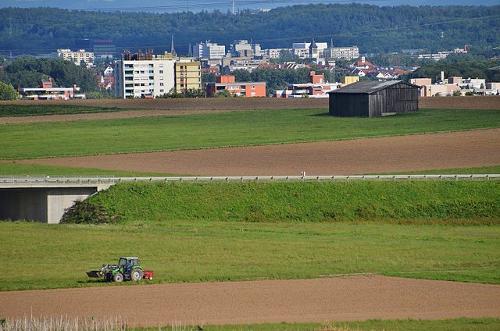 Land construction activities just outside a city in GermanyPhoto: Qwesy qwesy CC 3.0 Unported no changes made
Land construction activities just outside a city in GermanyPhoto: Qwesy qwesy CC 3.0 Unported no changes made
The most important German states for forestry are Bavaria, Baden-Württemberg, Hesse, Rhineland-Palatinate, Pomerania, Thuringia and the Saxon mountains. Almost one third of Germany (10.3 million ha) is covered by forest and, in addition to timber extraction, the forest is of great importance for recreation and environmental protection.
In places where trees are felled, there is a legal obligation to plant new trees. In the eighties, more and more damage was observed to the forests as a result of the acid rain. Germany is trying to reduce air pollution by means of national and international measures.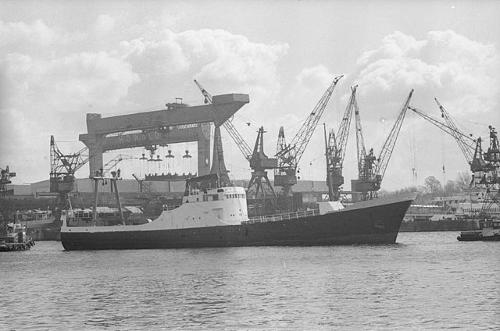 German fishing vesselPhoto: Magnussen, Friedrich (1914-1987) CC3.0 Germany no changes made
German fishing vesselPhoto: Magnussen, Friedrich (1914-1987) CC3.0 Germany no changes made
Fisheries have been modernized considerably in recent years, but due to the catch limits imposed by the EC, the survival of deep-sea, cutter and coastal fisheries is threatened. The import of very cheap fish from the former Eastern Bloc countries also hampers German sales.
The German fishing fleet has more than 2000 ships. With 36% of the total catch, the North Sea is the most important sea for German fishermen. Other important fishing areas are the Baltic Sea, the coast of Greenland and the areas around Great Britain. The main sales countries are the Netherlands, Spain, Iceland and Denmark.
Mining and energy supply
The German soil is extremely poor in raw materials and has very modest quantities of iron ore, oil and natural gas, for example. On the other hand, reserves of coal, lignite and salt are abundant, but their extraction is hardly or not profitable due to the high labor costs.
Coal is mainly mined in the Ruhr area and the Saarland, lignite near Helmstedt and Cologne and around the East German cities of Leipzig, Halle, Dresden and Cottbus. The extraction and use of lignite as fuel has caused serious environmental problems in those areas. Fortunately for the environment, natural gas is taking over the function of lignite in the new provinces. Salt is extracted from, among others, Fulda.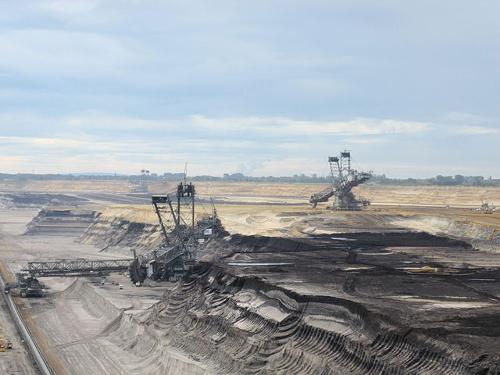 Lignite is extracted through opencast mining in GermanyPhoto: Haloorange CC 3.0 Unported no changes made
Lignite is extracted through opencast mining in GermanyPhoto: Haloorange CC 3.0 Unported no changes made
Energy needs are met by oil, natural gas, coal and nuclear energy. Rich natural gas discoveries were made in East Frisia. Approx. 30% of the imported natural gas comes from the Netherlands. The use of nuclear energy is being phased out faster after the accident in Fukishima. Germany is taking many initiatives in green energy.
Industry
West Germany
More than half of industrial companies have fewer than 50 employees and only 5% are companies with more than 500 employees. More than half of all employees work in these large companies and they also supply more than half of the total industrial production. Large corporations are mainly found in the coal, steel, petroleum, chemical and automotive industries. The main primary industry is the chemical industry (Hoechst, BASF and Bayer) with approximately 500,000 employees. Machine and equipment manufacturing and the production of means of transport are also very important.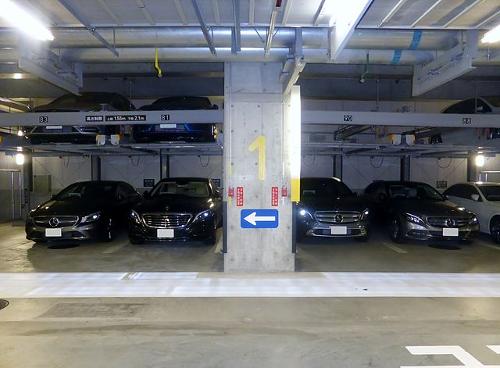 Mercedes Benz, top brand from GermanyPhoto: Tokumeigakarinoaoshima CC 3.0 Unported no changes made
Mercedes Benz, top brand from GermanyPhoto: Tokumeigakarinoaoshima CC 3.0 Unported no changes made
After the United States and Japan, Germany is the third largest passenger car producer worldwide. The electrical engineering industry and the production of desk machines and computers are at a high level and employ more than a million people. Of the consumer goods industry, textiles and upholstery are of particular importance. Germany is Western Europe's largest producer of, among other things, pig iron and crude steel, rolling mill products and cotton yarns and fabrics. Heavy industry dominates in the Ruhr area, and this area has been the center of the West German economy for many decades.
Even before the reunification of the two Germanys, various partnerships had already been established between the West and East German industry. In March 1990, the Treuhandanstalt, the organization that would coordinate the privatization of East German state-owned companies, was founded.
East Germany
Eisenhüttenstadt is the main seat of heavy industry. The city is located on the Oder, which means that much of the raw material can be transported over water and the cast iron can be transported away. Another center of cast iron production is Calbe, where the iron ores (with a low content) from the Harz Mountains and coke from lignite are processed. Despite the results achieved, the major shortcoming remains that the metalworking industries do not have their own raw material base, leaving them in a vulnerable position. Mechanical engineering, metal industry, chemical industry and textile industry are the main industries. The geographic distribution of the industry is broadly as follows:
machine building and metal industry mainly in Saxony and Thuringia (Chemnitz, Magdeburg, Leipzig, Weimar, Dresden);
automotive industry in Eisenach, Zwickau and Brandenburg;
shipbuilding in Rostock;
light metal industry in Thuringia;
optical industry in Jena and Dresden;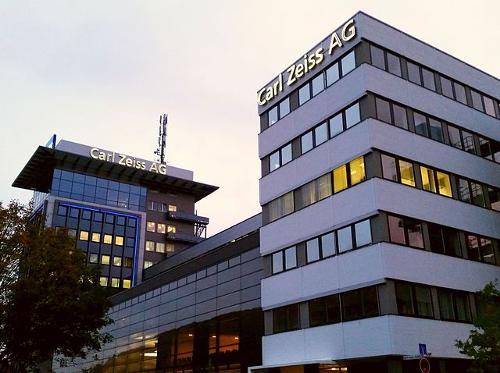 Main building Carl Zeiss AG, manufacturer of optical devices in JenaPhoto: Ardwareonkel CC 4.0 International no changes made
Main building Carl Zeiss AG, manufacturer of optical devices in JenaPhoto: Ardwareonkel CC 4.0 International no changes made
electrical engineering industry in Leipzig, Erfurt and Dresden;
chemical industry mainly in the area of Leuna-Schkopau-Bitterfeld, in Berlin and Dresden;
textile industry in the area (Chemnitz) -Zwickau-Plauen;
rubber industry in Gotha, Leipzig and Riesa;
food, beverage and tobacco industry in Thuringia (meat products) and Saxony-Anhalt (preserved).
Various economic sectors
Construction and infrastructure
In the early 1990s, this sector benefited from the many reconstruction projects in eastern Germany. The greater demand in the west for housing by the migrants from the eastern part of Germany also led to a lot of construction activities. However, since 1995, the construction industry has been in a dip, particularly the housing sector.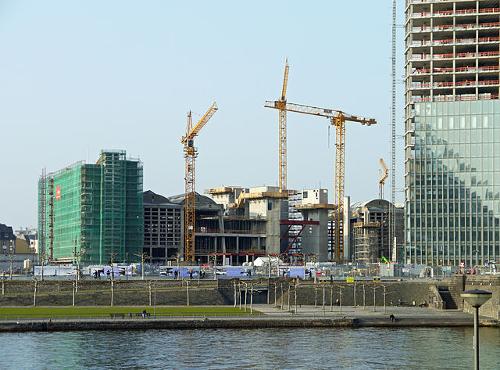 Construction activities in Frankfurt Am Main, GermanyPhoto: Simsalabimbam CC 3.0 Unported no changes made
Construction activities in Frankfurt Am Main, GermanyPhoto: Simsalabimbam CC 3.0 Unported no changes made
In total there are approximately 80,000 companies active in the construction sector, three quarters of which are small companies with less than 20 employees. In total, approximately 1 million people still work in the construction sector. The number of jobs has fallen sharply since the early 1990s. One of the causes is the high wages with which the German construction sector works. For large construction projects, a lot of work is now done with foreign contractors who work with cheap Eastern European construction workers.
Chemistry and plastics
Germany is the third largest chemical producer in the world after the United States and Japan. The production of chemical raw materials is the most important in Germany with almost 50%. After that come the pharmaceutical products with nearly 20% and paints, sealants and inks with 8%.
The sector has approximately 470,000 employees, making it the sixth largest employer in Germany. In total there are about 1750 companies, of which only about 10% have more than 500 employees. The main chemical companies are BASF, Bayer, Degussa-Hüls, Celanese and Procter & Gamble.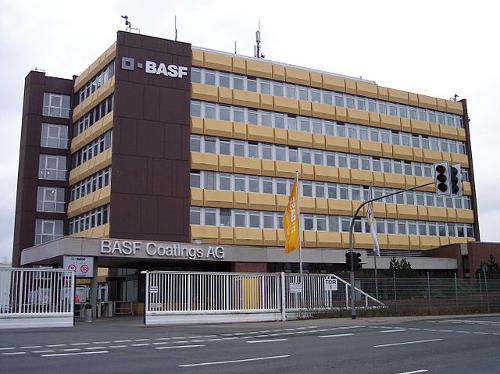 Building of BASF Coatings in MünsterPhoto: Stahlkocher CC 3.0 Unported no changes made
Building of BASF Coatings in MünsterPhoto: Stahlkocher CC 3.0 Unported no changes made
Food retailing
Compared to the rest of Europe, this branch has developed differently. Almost all large companies focus on the lower segment of the market. Discounters and in particular the arrival of Aldi on the German market has had a major impact on the food retail trade, which is therefore subject to very high price competition.
The German top 5 had a market share of approximately 65% in 2000 and further concentration is expected to increase to 82% in 2014.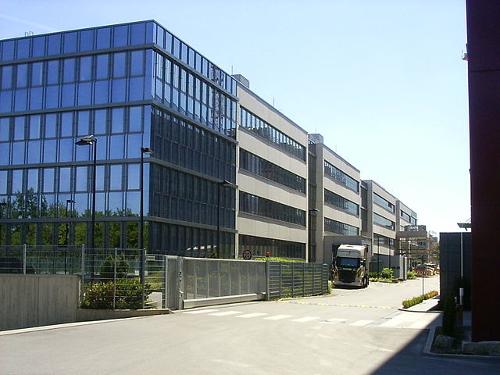 Lidl headquarters in NeckarsulmPhoto: Pimvantend CC 3.0 Unported no changes made
Lidl headquarters in NeckarsulmPhoto: Pimvantend CC 3.0 Unported no changes made
Banking sector
The Bundesbank is the central bank of Germany and is responsible for, among other things, the settlement of domestic and foreign payments, the supply of banknotes and coins and is the home bank of the state and the Bundesländer. The nine Landeszentralbanks act as headquarters of the Bundesbank with extensive independence and individual responsibility.
There are also:
- Large private banks that are active in all areas of financial services.
- Public-law savings banks are widely spread in Germany and mainly focus on services to private individuals and small and medium-sized businesses.
- The Volks- und Raiffeisen banks (so-called cooperative banks) mainly focus on rural areas.
- Smaller and medium-sized commercial banks; Bausparkassen; specialized institutions such as investment banks, building societies and ship mortgage banks.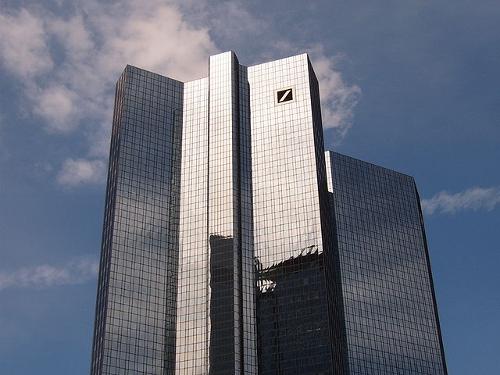 Headquarters Deutsche bank in Frankfurt Am MainPhoto: Markus Bernet CC 2.5 Generic no changes made
Headquarters Deutsche bank in Frankfurt Am MainPhoto: Markus Bernet CC 2.5 Generic no changes made
Electronics industry
Growth segments include electronic components, semiconductors, products and systems for automation, drive systems, switchgear, switchgear and industrial control systems.
Top 10 German electronics industry:
1. Siemens
2. Bosch
3. Philips Germany
4. ABB Germany
5. Alcatel Germany
6. Hella
7. Miele
8. Electrolux Germany
9. Braun
10.Grundig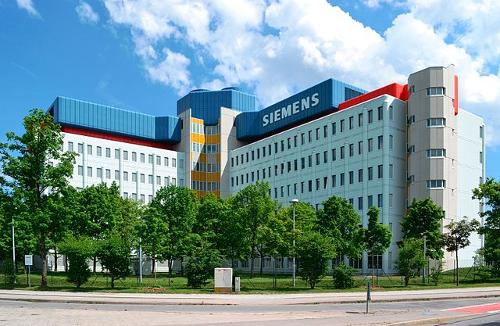 Buildng of Siemens in NeuperlachPhoto: High Contrast CC3.0 Germany no changes made
Buildng of Siemens in NeuperlachPhoto: High Contrast CC3.0 Germany no changes made
Energy sector
The main energy carriers for generating electricity are coal and lignite. However, more than half of the primary energy must be imported, including almost all oil. The main gas suppliers for Germany are Russia, Norway and the Netherlands.
Machine industry
Machine and equipment construction had more than 900,000 employees in 2013 and there were approximately 6,000 companies active at the time. This sector is therefore the largest sub-sector in the processing industry. The main export countries are the United States, France, England, Italy and the Netherlands
Mining
Germany has large stocks of coal and lignite and is the largest lignite producer in the world with approximately 150 million tons. The coal basins are mainly located in the northern Ruhr area and in Saarland. There are still 15 mines in operation and around 2014 there are still 10 mines open.
Expensive, heavily subsidized coal production has been declining sharply in recent years, and a further reduction in production is also anticipated for the coming years. Both private business and the government are active in the coal industry. The situation for the lignite industry is somewhat more favorable because extraction and production are cheaper and therefore more profitable. However, opencast lignite production is causing enormous damage to the landscape and is subject to strong criticism. Furthermore, Germany is poor in minerals, although there are, for example, several salt mines still in operation.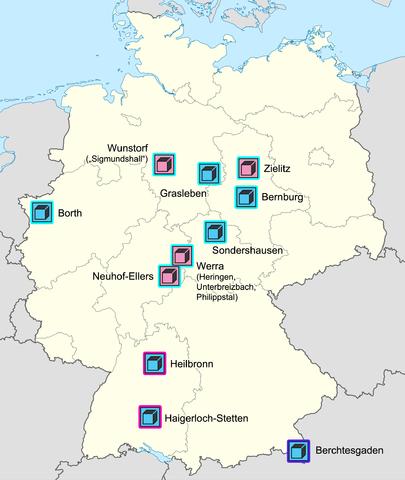 Locations saltmines in GermanyPhoto: Gretarsson CC 3.0 Unported no changes made
Locations saltmines in GermanyPhoto: Gretarsson CC 3.0 Unported no changes made
Automotive industry
The German automotive industry is the largest in Europe with a market share of approximately 17%. The German automotive industry is mainly concentrated in the states of Hesse, Bavaria, Baden-Württemberg, North Rhine-Westphalia, Thuringia and Saxony.
The main export countries are Italy, Great Britain, United States and France.
Top 5 German automotive industry:
1. DaimlerChrysler
2. Volkswagen
3. BMW
4. Adam Opel
5. Ford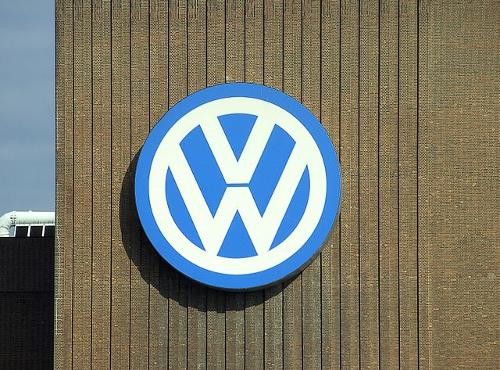 Logo VolkswagenPhoto: High Contrast CC 3.0 Germany no changes made
Logo VolkswagenPhoto: High Contrast CC 3.0 Germany no changes made
Biotechnology
Biotechnology is an important growth market, but it accounts for less than 1% of total turnover in the chemical industry. Still, the German biotechnology sector is the third most important in the world after the United States and Great Britain.
The main biotechnology centers in Germany are located in the regions around Munich, Berlin, Heidelberg and Mannheim.
ICT sector (information-communication-telecommunications)
The German ICT sector is the third largest market in the world after the United States and Japan, with a share of 5.7%.
The number of internet users is growing explosively in Germany. There is a computer in almost every German household.
Germany has the largest telecommunications market in Europe and is the third largest market in the world. Germany is a leader in Europe in the field of ISDN connections. Mobile telephony is one of the fastest growing subsectors.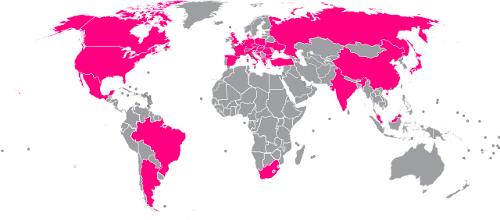 Deutsche Telekom locations worldwidePhoto: Peeperman CC 3.0 Unported no changes made
Deutsche Telekom locations worldwidePhoto: Peeperman CC 3.0 Unported no changes made
Trade
The value of imports was $ 1,104 billion in 2017 and the value of exports was $ 1,401 billion. The trade balance thus shows a considerable surplus. The services balance, on the other hand, shows a large negative balance, mainly due to German tourism abroad and exports by foreign workers. Most of the exports are machines, cars, electrical and chemical products. Food, beverages, tobacco, oil and natural gas mainly play a role in imports. Trade has increased significantly within the European Communities.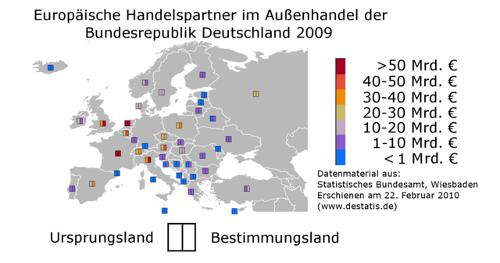 Trade figures between Germany and Europe (2009)Photo: NkMap-Europe-v5.png: Zaparojdik CC3.0 Unported no changes made
Trade figures between Germany and Europe (2009)Photo: NkMap-Europe-v5.png: Zaparojdik CC3.0 Unported no changes made
Germany's main trading partners are western, often European industrialized countries. More than half of the foreign trade proceeds come from trade with EU member states. Trade with Central and Eastern European countries such as Russia, the Baltic states, Poland and the Czech Republic is also increasing. Outside Europe, the United States and Japan are the most important trading partners and trade with other Asian countries and countries around the South Pacific is also intensifying.
Traffic
The largest transport company is the Deutsche Eisenbahn A.G. (DEAG), privatized since 1994. In 2002, Germany had 41,8100 kilometers of rail, of which nearly 20,000 kilometers were electrified.
Only 20% of passenger traffic takes place by public transport.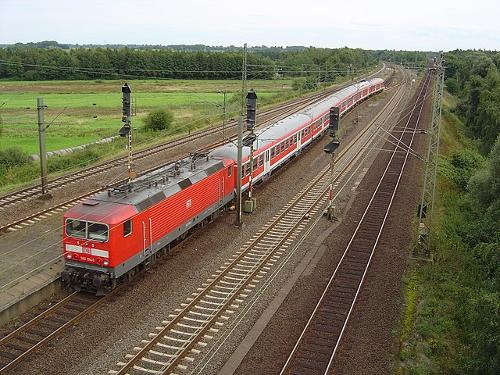 Train of the Deutsche Bundesbahn (DB)Photo: User:Wiki-observer CC 2.5 Generic no changes made
Train of the Deutsche Bundesbahn (DB)Photo: User:Wiki-observer CC 2.5 Generic no changes made
The truck is the most important means of transport for domestic transport. In the 1950s the railways was still the main transporter, followed by inland shipping and then road transport. Truck transport now takes care of 80% of all goods transport.
Ocean shipping, with Hamburg, Wilhelmshaven, Bremen, Bremerhaven, Lübeck, Kiel, Rostock, Wismar and Stralsund as the main ports, is of great importance to the German economy. Important receiving and destination countries are Great Britain, Denmark, Norway, Sweden and the Netherlands. The German merchant navy has approximately 1,400 ships with a loading capacity of approximately 7 million tonnes gross registered tons.
Inland navigation on rivers and canals (6500 km navigable) is very busy; more than 60% of inland shipping takes place on the Rhine, the busiest inland waterway in Europe. The main ports here are Duisburg, Cologne, Mannheim, Karlsruhe and Ludwigshafen. Duisburg is the largest inland port in Europe. Container transport is becoming increasingly important.
Top 10 German inland ports by goods turnover:
Duisburg
Cologne
Hamburg
Mannheim
Ludwigshafen
Karlsruhe
Heilbronn
Berlin
Frankfurt am Main
Neuss
Inland shipping has a fleet of approximately 3000 ships and is a relatively cheap and environmentally friendly means of transport. After road and rail transport, inland waterway transport ranks third in freight transport.
Aviation is provided by the Deutsche Lufthansa A.G. (founded in 1953) in Cologne. The main airport is Frankfurt, followed by Düsseldorf, Hamburg, Munich, Hanover, Tegel in the west, Schönefeld in the east and Tempelhof in the south of the city of Berlin.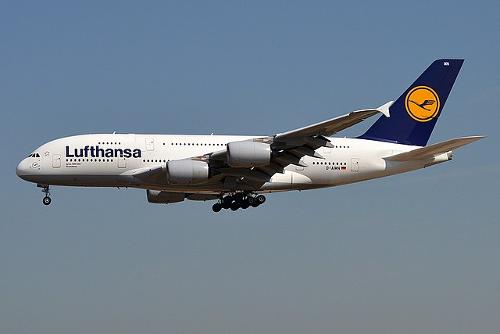 Lufthansa, national airline of GermanyPhoto: Anna Zvereva from Tallinn, Estonia CC 2.0 Generic no changes made
Lufthansa, national airline of GermanyPhoto: Anna Zvereva from Tallinn, Estonia CC 2.0 Generic no changes made
Air transport is becoming increasingly important in Germany. The main flight destinations of the Germans are Spain (Mallorca and the Canary Islands), Great Britain, United States, Turkey, Greece, Italy and France.
The main domestic air connections are Frankfurt-Berlin (Tegel), Munich-Düsseldorf, Frankfurt-Hamburg, Frankfurt-Munich and Munich-Berlin.
Sources
Ayer, E.H. / Germany
Lucent Books
Egert-Romanowska, J. / Duitsland
Van Reemst
Europese Unie : vijftien landendocumentaties
Europees Platform voor het Nederlandse Onderwijs
Mark, D.F.W. van der / De Bondsrepubliek Duitsland voor en na 1990 : geschiedenis, politiek, economie en ruimtelijke ontwikkeling
Landensurveys
Tatsachen über Deutschland
CIA - World Factbook
BBC - Country Profiles
Copyright: Team The World of Info